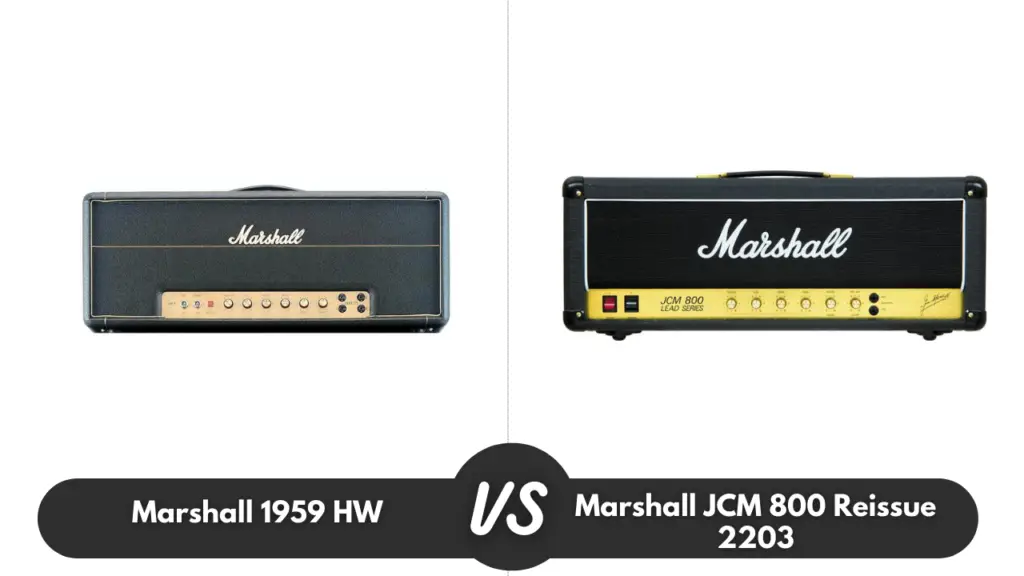Marshall is arguably one of the greatest brands when it comes to electric guitar amps. With their legendary amps adorning the stages of some of rock’s biggest names, their amps remained popular in the 21st century.
Known for their signature “crunch”, Marshall has been considered game-changers for developing the saturated “distorted” sound that many of us are familiar with.
With renowned stars such as Angus Young (AC/DC), Zakk Wylde (Black Label Society) and Joe Satriani on their roster, Marshall has always had an impressive reputation.
Let’s take a quick look at the popular Marshall amps, the 1959 HW Plexi and the JCM 800 Reissue.
| Price: | £1,759 | £1,499 |
| Max Wattage: | 100W | 100W |
| Footswitch: | No | No |
| Weight: | 21 kg | 18.8 kg |
Marshall 1959 HW
The Marshall 1959 ‘Plexi’ amp is arguably one of the most famous amps of all time. It’s a Super Lead 100 sat atop two 4 x 12 Celestion-loaded cabs and is still for many people the definitive rock guitar rig. Hendrix, Clapton, Beck, Page and Van Halen, just to name a few, have all created history using this amp, recording some of the most influential tracks ever.
Design
The Plexi’s control panel consists of four input jacks that feed two parallel preamp stages. One is voiced brighter than the other, along with separate volume knobs and shared three-band EQ and a presence control. It doesn’t have a master volume or channel switching – making it a simple brute of an amp, which has been the secret behind its monstrous tonal power.
It’s worth mentioning that amps from this period were very much ‘works in progress”. Amps like this experienced component changes, sometimes because of a change in design or supplier, other times purely for expedience – for example, changing to the nearest value when stocks of a certain capacitor ran out in order to keep production moving along.
This is the main reason why these early amps varied so much in tone. Since then, Marshall has been taken to ensure the new Hand-Wired version is more consistent.
Sound Quality
The new Plexi by Marshall excels with greater headroom, less noise and a darker, less aggressive treble, making soloing a sheer unadulterated pleasure.
The 1959’s brutal power and endless headroom is perfect for big arenas and outdoor festivals. However, you won’t have any problems taming it for smaller venues. Using a small jumper lead to combine both channels is great for achieving the real ‘Plexi’ tone. With this plugged in, you’ll get a thicker sound, which can be fine-tuned by balancing one volume control against the other.
An attenuator such as the THD Hot Plate allows you to wind up the volume controls to get the output valves working properly while using a small amount of extra front-end gain from a good overdrive pedal will help to push the preamp.
You can get some frighteningly accurate Hendrix sounds from a Japanese reissue Strat. When using a Les Paul, every classic riff played on this combination becomes remarkably pure. Think Cream-era Clapton through to AC/DC; it’s impressive to hear such a great sound coming from such a simple circuit.
Marshall JCM 800 Reissue 2203
Marshall’s JCM800 vintage reissue has nailed the power and crunch of the original and only improved upon it with the addition of the effects loop.
The Marshall JCM 800 has earned a privileged place among the best guitar amplifiers out there. There’s nothing more iconic than seeing a Marshall amp head perched upon a matching black 4×12 cabinet. From Hendrix to Clapton, Bon Jovi to Van Halen, many rock guitarists have embraced the power and tone of the Marshall amp. Introduced in ‘80, the original JCM800 was a milestone for the renowned British amp brand. The amp featured a single channel with a master volume control, which allowed for more saturated sounds at lower volumes. The JCM800 has since become part of Marshall’s “vintage” line of amplifiers, and the question for many is how well the reissue stacks up to the original.
Design
The JCM800 reissue 100W head features 3 x ECC83 (12AX7) preamp tubes and 4 x EL34 power amp tubes. Its control layout is simple, as it has individual controls for presence, bass, middle, treble, master volume, and pre-amp volume. The big difference between the original and the reissue is that the reissue has a true bypass effects loop that’s completely out of the circuit when unused, which allows the amp to sound more like the original.
Sound Quality
So how does the JCM800 reissue sound? It sounds like pure rock and roll. After all, this is an amp that defined rock and metal for the 1980s, and it still shows. If you’re more into jazz and country in addition to blues and rock, then you will need to look elsewhere because the JCM800 is a one-trick pony.
If you mainly use amps for small venues like your bedroom or a small club, then you’re going to need a power soak or, at the very least, a good overdrive pedal to coax the best tones from this Marshall because it really only sounds its best when cranked. When you’ve got the preamp cranked and with the master volume above six, is when the amp really starts to open up. Its dynamic range is impressive, with the distortion being what you’d expect from a reissue Marshall JCM800. Its tonal emphasis is in the upper midrange, which adds to the classic metal crunch.
Conclusion
Both of these amps are going to growl, although it’s a very different growl. While one of the big differences is the Master Volume, the other is just the sound of the growl. Plexi’s are generally considered to be much smoother, while the JCM800 have more attitude and a little more bite.
